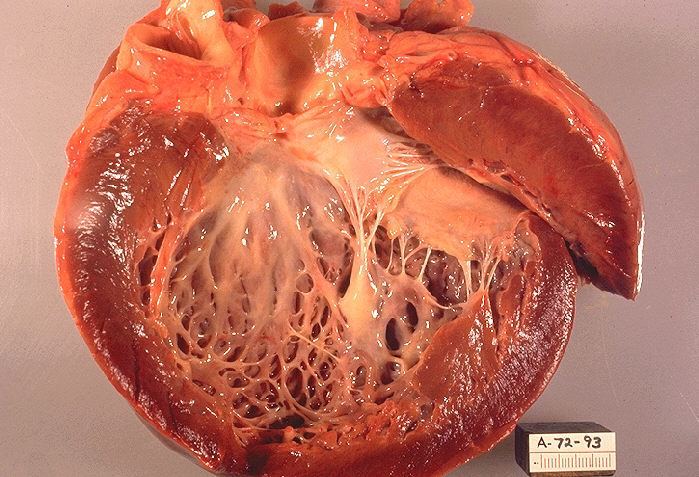ICD-9-CM 425 MedlinePlus 001105 | ICD-10 I25.5, I42, I43 DiseasesDB 2137 Patient UK Cardiomyopathy | |
 | ||
Cardiomyopathy is a group of diseases that affect the heart muscle. Early on there may be few or no symptoms. Some people may have shortness of breath, feel tired, or have swelling of the legs due to heart failure. An irregular heart beat may occur as well as fainting. Those affected are at an increased risk of sudden cardiac death.
Contents
Types of cardiomyopathy include hypertrophic cardiomyopathy, dilated cardiomyopathy, restrictive cardiomyopathy, arrhythmogenic right ventricular dysplasia, and broken heart syndrome. In hypertrophic cardiomyopathy the heart muscle enlarges and thickens. In dilated cardiomyopathy the ventricles enlarge and weaken. In restrictive cardiomyopathy the ventricle stiffens.
The cause is frequently unknown. Hypertrophic cardiomyopathy is often and dilated cardiomyopathy in a third of cases, is inherited from a person's parents. Dilated cardiomyopathy may also result from alcohol, heavy metals, coronary heart disease, cocaine use, and viral infections. Restrictive cardiomyopathy may be caused by amyloidosis, hemochromatosis, and some cancer treatments. Broken heart syndrome is caused by extreme emotional or physical stress.
Treatment depends on the type of cardiomyopathy and the degree of symptoms. Treatments may include lifestyle changes, medications, or surgery. In 2013 cardiomyopathy and myocarditis affected 7.9 million people. Hypertrophic cardiomyopathy affects about 1 in 500 people while dilated cardiomyopathy affects 1 in 2,500. They resulted in 443,000 deaths up from 294,000 in 1990. Arrhythmogenic right ventricular dysplasia is more common in young people.
Signs and symptoms
Symptoms of cardiomyopathies may include fatigue, swelling of the lower extremities and shortness of breath.
Cause
Cardiomyopathies are either confined to the heart or are part of a generalized systemic disorder, both often leading to cardiovascular death or progressive heart failure-related disability. Other diseases that cause heart muscle dysfunction are excluded, such as coronary artery disease, hypertension, or abnormalities of the heart valves.
Earlier, simpler, categories such as intrinsic, (defined as weakness of the heart muscle without an identifiable external cause), and extrinsic, (where the primary pathology arose outside the myocardium itself), became more difficult to sustain. For example, as more external causes were recognized, the intrinsic category became smaller. Alcoholism, for example, has been identified as a cause of dilated cardiomyopathy, as has drug toxicity, and certain infections (including Hepatitis C). On the other hand, molecular biology and genetics have given rise to the recognition of various genetic causes, increasing the intrinsic category. For example, mutations in the cardiac desmosomal genes as well as in the DES gene may cause arrhythmogenic right ventricular cardiomyopathy (ARVC).
At the same time, a more clinical categorization of cardiomyopathy as 'hypertrophied', 'dilated', or 'restrictive', became difficult to maintain when it became apparent that some of the conditions could fulfill more than one of those three categories at any particular stage of their development. The current American Heart Association definition divides cardiomyopathies into primary, which affect the heart alone, and secondary, which are the result of illness affecting other parts of the body. These categories are further broken down into subgroups which incorporate new genetic and molecular biology knowledge.
Types
Cardiomyopathies can be classified using different criteria:
Mechanism
Symptoms may include shortness of breath after physical exertion, fatigue, and swelling of the feet, legs, or abdomen. Additionally, arrhythmias and chest pain may be present.
The pathophysiology of cardiomyopathies is better understood at the cellular level with advances in molecular techniques. Mutant proteins can disturb cardiac function in the contractile apparatus (or mechanosensitive complexes). Cardiomyocyte alterations and their persistent responses at the cellular level cause changes that are correlated with sudden cardiac death and other cardiac problems.
Diagnosis
Among the diagnostic procedures done to determine a cardiomyopathy are:
Treatment
Treatment may include suggestion of lifestyle changes to better manage the condition. Treatment depends on the type of cardiomyopathy and condition of disease, but may include medication (conservative treatment) or iatrogenic/implanted pacemakers for slow heart rates, defibrillators for those prone to fatal heart rhythms, ventricular assist devices (VADs) for severe heart failure, or ablation for recurring dysrhythmias that cannot be eliminated by medication or mechanical cardioversion. The goal of treatment is often symptom relief, and some patients may eventually require a heart transplant.
